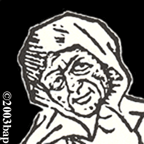

Buy the Book!
The WITCH HUNTS
(A.D.
1400-1800)
Main Contents Page


|
|
The WITCH HUNTS
|

|
From the fifteenth to the eighteenth the centuries, many Europeans developed a heightened concern with the phenomenon of witchcraft, seeing a new sect hostile to humanity. Thus, governments and society organized "hunts" for these alleged witches: accusing, torturing, and executing thousands of people. The intensity and viciousness of these hunts varied from place to place, as did their focus on particular targets, such as women. Finally, a changed world-view, informed by the Scientific Revolution and the Enlightenment, brought an end to these hunts for threats that did not empirically exist.
|
Ten
Theories about the Causes of the Witch Hunts |
Ten Common Errors and Myths about the Witch Hunts: |
Timeline: |
|
Annotated
Bibliography: |
Torture: |
Annotated Links: |
These pages, as part of Prof. Pavlac's Women's History Resource Site, hope to contribute to a better understanding of this dreadful historical chapter of Western Civilization. These pages have been developed out of the following courses:
| HIST 444 The Witch Hunts: 1400-1800 | HIST 373 Women in Western Civilization |
| For other courses about the Witch hunts, click here. |
Disclaimer/Warning/Caution
Some of the site contents have been written by students, of varying ability. Some
pages have been only minimally edited and may contain inadequate information. You should use these pages as only
a starting point for research about the facts, scholarship and internet sites
available concerning historical women. And Prof. Pavlac usually does not
have much further information on any subjects beyond that which is already provided on
any particular page.
King's College, and/or the History Department faculty and/or Prof. Pavlac do not
necessarily endorse the views or opinions published here nor substantiate all
information as fully accurate or factual.
This website, its author(s), and/or provider do not necessarily agree with and are
not responsible for the information, opinion, or views of linked pages and
sites. The content of pages we link to are the responsibility of their own authors.
We apologize for any links that no longer connect.
In addition to the brief summary below, this site includes the following pages which provide resources for understanding the phenomenon of the European Witch Hunts:
Brief Historical Summary
of the European Witch Hunts
by
Erin Nummey, 1998
The European Witch Craze started roughly during conclusion of the 15th century and peaked during the first half of the seventeenth century. The belief that women were sinful and had the power of the devil within them developed out of the Middle Ages. The Reformation further promoted the idea of a satanic kingdom of evil on earth with which to justify persecutions. Theologians sought to prove that accused witches represented the devil.
The first and most significant written cumulative concept of witchcraft available to a large audience was the Malleus Maleficarum written by Sprenger and Kraemer. It was first published in 1486 and reprinted fourteen times before 1520. The document made an important contribution to the widespread witch hunt. Most people accused of witchcraft were rural, poor, and single women. The hunts are often seen as a massive effort to keep women in their place. Women were seen as evil, and unclean people whose weakness could summon the devil for sexual intercourse.
The Malleus Maleficarum document ignited a widespread hunt for the so-called witches described in it. During the hunt, witches were accused of "impractical" and "traceless" crimes such as intercourse with the devil, unregistered babies from hidden pregnancies who were supposedly eaten or sacrificed, and even natural disasters. However there is no record of any solid evidence for any of these accused crimes.
Often these hunts were instigated by hysterical children, or nuns who accused relatives, and neighbors of these outrageous crimes. Witnesses were often bribed or threatened in order to prosecute the accused. The accused would then be tortured until they confessed. The methods of torture were very cruel and painful, and almost all who were put through the various devices would confess. In some cases the accused would die of torture, and very few survived the ordeal without confessing. However, the accused was set free if they survived the torture without a confession. After the forced confession, the trial took place. These trials were run by genuine believers of witchcraft. The aim of the trial was to exterminate the witches as conspirators with the devil. When the accused was declared guilty, they were usually executed.
Although, there are many estimates as to how many actual people were killed during these hunts, most estimates show the number well below the one-million mark. The actual number of documented executions, is generally considered to be under one hundred thousand. Of all that were executed, only a minority were men, and of those men, many are those who tried to protect accused women from the hunters.
|
Annotated Links |
|
|
URL:
http://departmens.kings.edu/womens_history/witch/ |